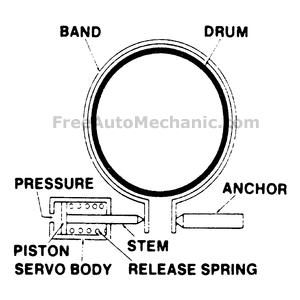Understanding the Automatic Transmission
The automatic transmission allows engine torque and power to be transmitted to the rear wheels within a narrow range of engine operating speeds. It will allow the engine to turn fast enough to produce plenty of power and torque at very low speeds, while keeping it at a sensible rpm at high vehicle speeds (and it does this job without driver assistance). The transmission uses a light fluid as the medium for the transmission of power. This fluid also works in the operation of various hydraulic control circuits and as a lubricant. Because the transmission fluid performs all of these functions, trouble within the unit can easily travel from one part to another. For this reason, and because of the complexity and unusual operating principles of the transmission, a very sound understanding of the basic principles of operation will simplify troubleshooting.
Transmission Troubleshooting
Transmission Temp Gauge
Transmission Application Guide
Transmission Torque Converter
The torque converter replaces the conventional clutch. It has three functions:
- It allows the engine to idle with the vehicle at a standstill, even with the transmission in gear.
- It allows the transmission to shift from range-to-range smoothly, without requiring that the driver close the throttle during the shift.
- It multiplies engine torque to an increasing extent as vehicle speed drops and throttle opening is increased. This has the effect of making the transmission more responsive and reduces the amount of shifting required.
The torque converter is a metal case which is shaped like a sphere that has been flattened on opposite sides. It is bolted to the rear end of the engine's crankshaft. Generally, the entire metal case rotates at engine speed and serves as the engine's flywheel.
The case contains three sets of blades. One set is attached directly to the case. This set forms the impeller or pump. Another set is directly connected to the output shaft, and forms the turbine. The third set is mounted on a hub which, in turn, is mounted on a stationary shaft through a one-way clutch. This third set is known as the stator.
A pump, which is driven by the converter hub at engine speed, keeps the torque converter full of transmission fluid at all times. Fluid flows continuously through the unit to provide cooling.
Under low speed acceleration, the torque converter functions as follows:

The torque converter housing is rotated by the engine's crankshaft, and turns the impeller. The impeller then spins the turbine, which gives motion to the turbine shaft, driving the gears.
The impeller is turning faster than the turbine. It picks up fluid at the center of the converter and, through centrifugal force, slings it outward. Since the outer edge of the converter moves faster than the portions at the center, the fluid picks up speed.
The fluid then enters the outer edge of the turbine blades. It then travels back toward the center of the converter case along the turbine blades. After making contact with the turbine blades, the fluid loses the energy picked up in the impeller.
If the fluid was now returned directly into the impeller, both halves of the converter would have to turn at approximately the same speed at all times, and torque input and output would both be the same.
In flowing through the impeller and turbine, the fluid picks up two types of flow, or flow in two separate directions. It flows through the turbine blades, and it spins with the engine. The stator, whose blades are stationary when the vehicle is being accelerated at low speeds, converts one type of flow into another. Instead of allowing the fluid to flow straight back into the impeller, the stator's curved blades turn the fluid almost 90� toward the direction of rotation of the engine. Thus the fluid does not flow as fast toward the impeller, but is already spinning when the impeller picks it up. This has the effect of allowing the impeller to turn much faster than the turbine. This difference in speed may be compared to the difference in speed between the smaller and larger gears in any gear train. The result is that engine power output is higher, and engine torque is multiplied.
As the speed of the turbine increases, the fluid spins faster and faster in the direction of engine rotation. As a result, the ability of the stator to redirect the fluid flow is reduced. Under cruising conditions, the stator is eventually forced to rotate on its one-way clutch in the direction of engine rotation. Under these conditions, the torque converter begins to behave almost like a solid shaft, with the impeller and turbine speeds being almost equal.
Lock-up Converter
The lock-up converter contains the same components as a conventional converter but also includes a clutch assembly that, when applied connects the engine directly to the transmission. The result is no slippage, and therefore virtually no power loss. An electronic control system is used to determine when to apply the converter clutch.
Transmission Planetary Gearbox
The ability of the torque converter to multiply engine torque is limited. Also, the unit tends to be more efficient when the turbine is rotating at relatively high speeds. Therefore, a planetary gearbox is used to carry the power output of the turbine to the driveshaft.

Planetary gears function very similarly to conventional transmission gears. However, their construction is different in that three elements make up one gear system, and, in that all three elements are different from one another. The three elements are: an outer gear that is shaped like a hoop, with teeth cut into the inner surface; a sun gear, mounted on a shaft and located at the very center of the outer gear; and a set of three planet gears, held by pins in a ring-like planet carrier, meshing with both the sun gear and the outer gear. Either the outer gear or the sun gear may be held stationary, providing more than one possible torque multiplication factor for each set of gears. Also, if all three gears are forced to rotate at the same speed, the gear set forms, in effect, a solid shaft.

Most automatics use the planetary gears to provide various reductions ratios. Bands and clutches are used to hold various portions of the gear sets to the transmission case or to the shaft on which they are mounted. Shifting is accomplished, then, by changing the portion of each planetary gear set which is held to the transmission case or to the shaft.
Transmission Servos/Accumulators
The servos are hydraulic pistons and cylinders. They resemble the hydraulic actuators used on many other machines, such as bulldozers. Hydraulic fluid enters the cylinder, under pressure, and forces the piston to move to engage the band or clutches.
Servo Operation

The accumulators are used to cushion the engagement of the servos. The transmission fluid must pass through the accumulator on the way to the servo. The accumulator housing contains a thin piston, which is sprung away from the discharge passage of the accumulator. When fluid passes through the accumulator on the way to the servo, it must move the piston against spring pressure, and this action smooths out the action of the servo.
Transmission Hydraulic Control System
The hydraulic pressure used to operate the servos comes from the main transmission oil pump. This fluid is channeled to the various servos through the shift valves. There is generally a manual shift valve, which is operated by the transmission selector lever, and a shift valve for each up shift the transmission provides.
Most automatic transmissions are electronically controlled; electrical solenoids are used to control the hydraulic fluid. The shift solenoids are regulated by an electronic control module. Shift timing is regulated through sensor feedback information provided to the electronic controller.
On older transmissions there are two pressures that control the shift valves. One is the governor pressure which is affected by vehicle speed. The other is the modulator pressure which is affected by intake manifold vacuum or throttle position. Governor pressure rises with an increase in vehicle speed, and modulator pressure rises as the throttle is opened wider. By responding to these two pressures, the shift valves cause the up shift points to be delayed with increased throttle opening to make the best use of the engine's power output.
Older transmissions also make use of an auxiliary circuit for down-shifting. This circuit may be actuated by the throttle linkage, vacuum that actuates the modulator, or by a cable or solenoid. It applies pressure to the down-shift surface on the shift valve or valves.
The transmission modulator also governs the line pressure, used to actuate the servos. In this way, the clutches and bands will be actuated with a force matching the torque output of the engine.
Mitchell1, also called eAutoRepair, is one of the best sources for Online automotive repair manuals. You will receive access to thousands of pages of comprehensive technical information, transmission break down diagrams, complete wiring schematics, drive belt routing, diagnostic trouble codes and much more.
Purchase Now and Access all the available information!

Ask a Mechanic
Free Insurance Quotes
Car Owners Manuals
Auto Wiring Diagrams
Auto Repair Manuals
Auto Repair Estimates
Hybrid Cars
Nut & Bolt Measuring Charts
Mechanic's Lien Form






